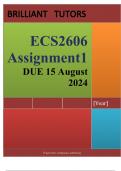BRILLIANT TUTORS
ECS2606
Assignment1
DUE 15 August
2024
[Year]
[Type the company address]
, Book
Environmental Economics
ECS2606 Assignment 1 (COMPLETE ANSWERS) Semester 2 2024 - DUE
15 August 2024 ; 100% TRUSTED Complete, trusted solutions and
explanations.
1. Discuss and diagrammatically illustrate the fundamental balance
principle. [10] Read the excerpt below and answer the question that
follows: Africa has made significant strides in the growth of its solar
energy industry in recent years, with the continent seeing an increase of
over 1.8W in new solar installations, primarily led by Egypt, South
Africa, Kenya, Namibia, and Ghana. In order to simultaneously speed up
energy access and support sustainable economic growth, Africa’s
renewable energy mix has increasingly switched away from
conventional hydropower and thermal facilities to renewable
alternatives.
Essential Equilibrium Standard
The essential equilibrium standard in ecological financial matters alludes to
the balance between natural quality and monetary exercises. It underscores
the need to adjust the advantages got from financial exercises, like creation
and utilization, with the expenses related with ecological debasement.
Accomplishing this equilibrium is pivotal for reasonable turn of events, where
monetary development doesn't come to the detriment of ecological wellbeing.
Key Parts:
1. Economic Exercises:
o Production and utilization of labor and products, which frequently lead to
natural externalities, like contamination and asset exhaustion.
2. Environmental Quality:
o The condition of the common habitat, including air, water, soil, and
biodiversity. Keeping up with high natural quality is fundamental for general
wellbeing and environment maintainability.
3. Marginal Advantages and Expenses:
, o Marginal Advantage (MB): The extra advantage got from consuming or
creating another unit of a decent or administration. In this specific
circumstance, it very well may be the financial advantages from expanded
creation or energy age.
o Marginal Cost (MC): The extra expense caused from delivering or
consuming another unit of a decent or administration, including the outer
expenses of ecological debasement.
Diagrammatic Representation:
The essential equilibrium rule can be represented utilizing a diagram that
shows the connection between minimal advantages and peripheral expenses.
Diagram Arrangement:
• X-pivot: Amount of monetary action or natural quality.
• Y-pivot: Peripheral advantage and minor expense.
Bends:
1. Marginal Advantage Bend (MB): Descending slanting, as the extra
advantage from financial exercises diminishes with expanded movement.
2. Marginal Expense Bend (MC): Up slanting, as the natural expense of
extra monetary exercises increments.
Balance Point:
• The ideal point is where the MB bend crosses the MC bend. Right now,
the minimal advantage of monetary action rises to the peripheral expense of
natural debasement. This equilibrium expands net social government
assistance, as any expansion in monetary action past this point would bring
about more prominent expenses than benefits.
Application to Africa's Sustainable power Advancement
With regards to Africa's developing sun powered energy industry, the key
equilibrium standard can be applied to the shift from ordinary energy sources
to sustainable other options. The passage features Africa's expanded spotlight
on sunlight based energy as a way to upgrade energy access and backing




